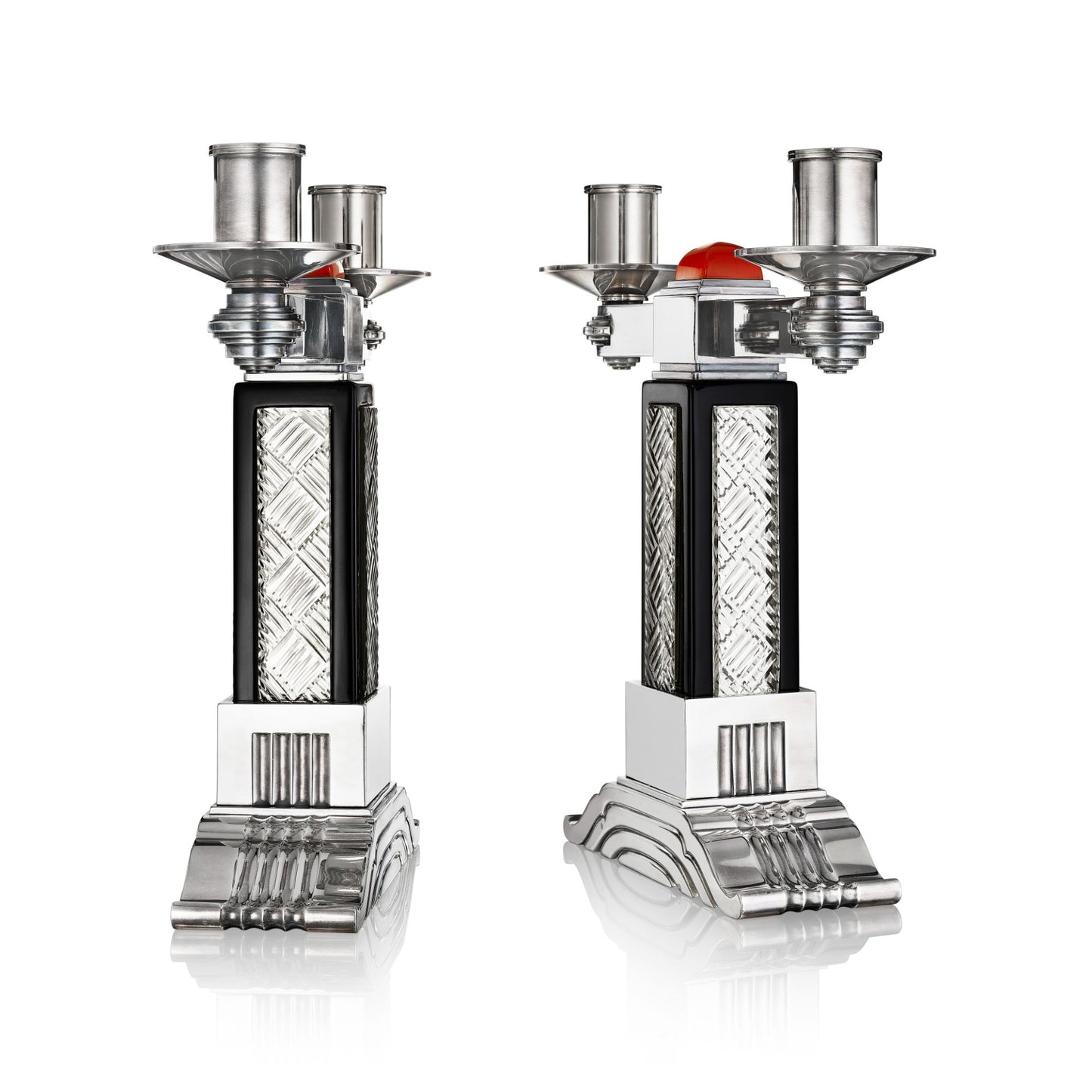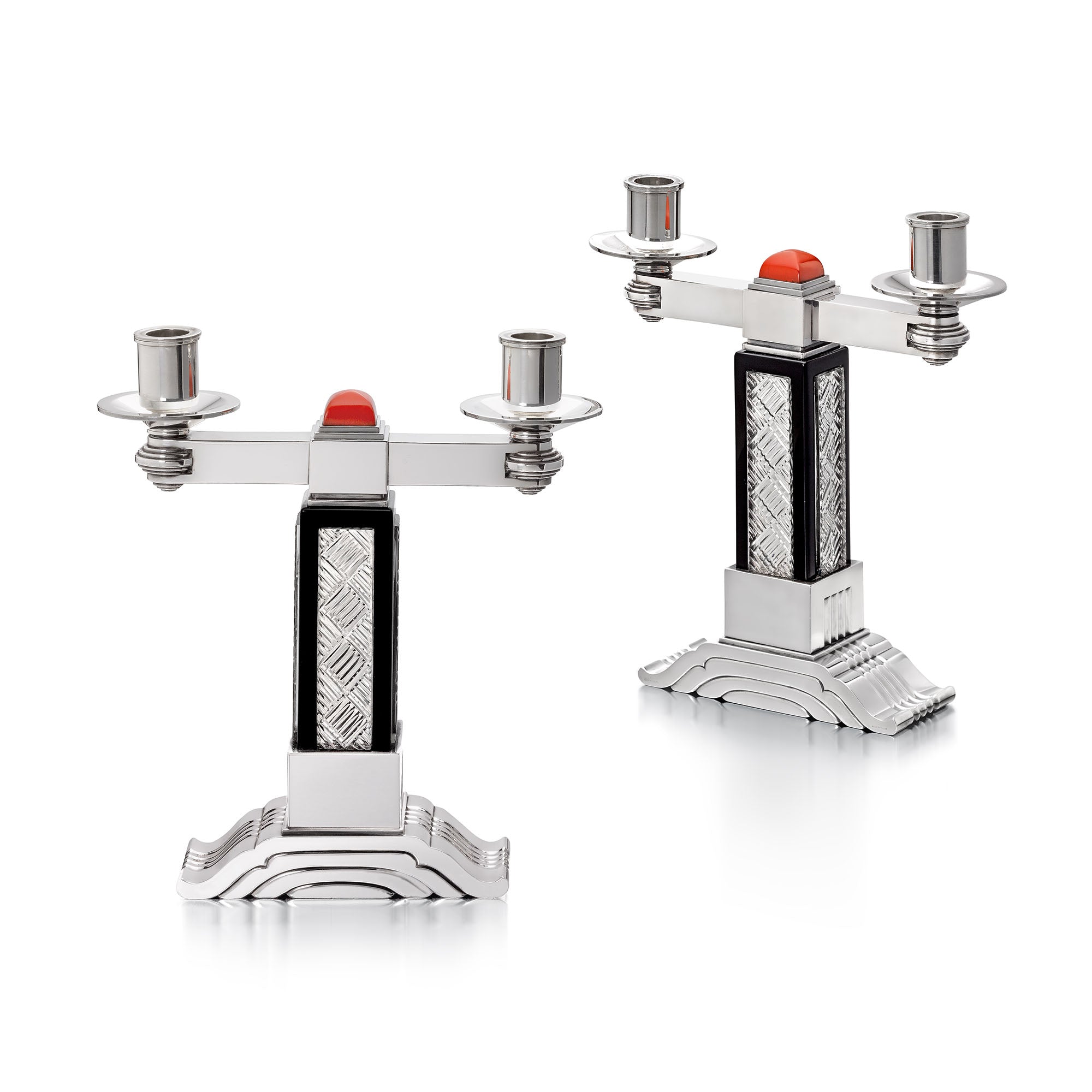PAIR OF ART DECO CANDELABRA MADE BY ROBERT LINZELER FOR CARTIER, PARIS, CIRCA 1930
PAIR OF ART DECO CANDELABRA MADE BY ROBERT LINZELER FOR CARTIER, PARIS, CIRCA 1930
A pair of candelabra each composed of two candle cups surmounting stepped forms of concentric circles connected by silver arms to a central post of black lacquer and cut glass topped by a red-lacquer sugarloaf imitating coral, the base of silver with decorative channels enhancing the curved form; mounted in sterling silver, with assay marks
- Signed Cartier, Made in France, stamped RL for Robert Linzeler
- Each: 9 × 2 1/2 × 9 3/4 inches
Additional cataloguing
Biography
Cartier was founded in Paris in 1847 by Louis-François Cartier. His three grandsons, Louis, Pierre, and Jacques, built the house into a famous international jewelry empire serving royalty, Hollywood stars, and socialites. Cartier has created some of the most important jewelry and objects of art of the twentieth century with many iconic designs such as mystery clocks, Tutti Frutti jewelry and the Panthère line. In 1983, The Cartier Collection was established with the objective of acquiring important pieces that trace the firm’s artistic evolution. Today, Cartier has 200 stores in 125 countries.
Significance
The need for safe and contained light goes back to the dawn of civilization. From fires and torches, candle making developed independently in Ancient Egypt, Rome, China, and India as far back as 3,000 b.c.e. with wax made from various plants and animals. The Romans made candelabra to hold their source of light, and archaeologist at Pompeii found a multitude of tall slender shafts supported by volutes and acanthus leaves so lavish they were copied by Renaissance artists. In the Middle Ages, candles and candelabra became important in ritualized religious ceremonies across faiths as a representation of power and love.
In the late 1800s, kerosene largely replaced candles as a source of light indoors and the fuel was in turn replaced by electricity in most houses in the 1920s. When Robert Linzeler created these exquisite candelabra for Cartier around 1930, candles were employed at dinner parties for their beauty as a source of warm flickering light. The exquisite cut crystal on the bases of this pair is designed to catch and scatter the light from the flame. Subtle details by a masterful designer give a nod to the Machine Age aesthetic that became popular with artist-jewelers in the 1930s. The candle-cups surmount stepped forms of concentric circles that bring to mind spinning machine parts, held in place by mechanical arms. The remaining details are pure Art Deco geometry, from the cuboid shaft, to the carved channels on the elegantly curved base.
This pair of candelabra was created by Robert Linzeler, a master silversmith working in Paris. At the turn of the century, Linzeler succeeded Juels Piault as the silversmith to Napoleon III and produced Paul Iribe’s jewels in 1911. In 1922, he partnered with Alexander Marchak. Linzeler et Marchak was one of only 30 exhibitors invited to show at the Paris 1925 Exposition des Arts Decoratifs where they won the Grand Prix for their immaculate jeweled boxes. After the exhibition, their partnership ended and Linzeler returned to manufacturing, often creating for Cartier, and the firm eventually purchased one of his workshops. This pair of candelabra was created in that brief period and is an impressive work of art modernizing an ancient form with exquisite design choices demonstrating Linzeler’s and Cartier’s ability to transform ordinary objects into coveted possessions. These candelabra would be beautiful lighting any table.







